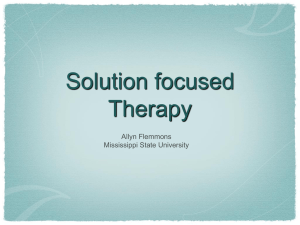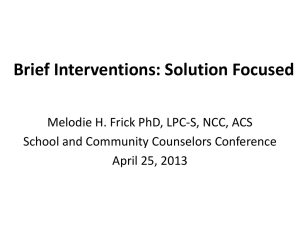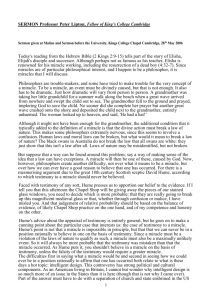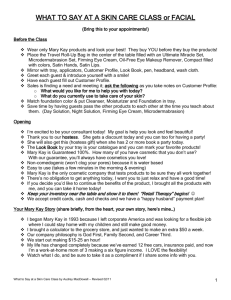Losing that sinking feeling
advertisement
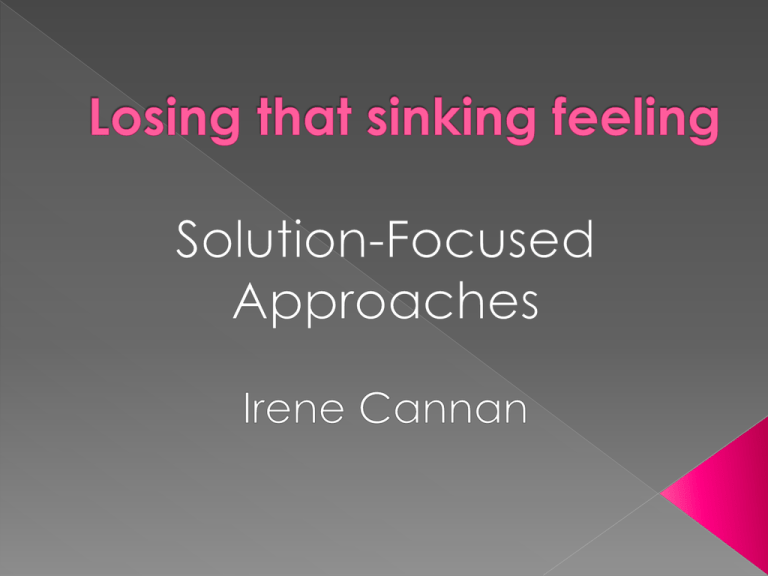
Solution Focused Therapy originated from the theories of psychotherapists working at the Brief Family Therapy Center in Milwaukee. These included Steve de Chazer, Insoo Kim Berg, Yvonne Dolan and Bill O'Hanlan. Solution Focused Therapy is a here-and-now type of psychotherapy that places emphasis on the present and future. Rather than analysing problems therapists will attempt to engage the client in conversation about potential solutions, operating from the viewpoint that change is not only possible but inevitable. It is a distinctly positive approach to psychotherapy. Change is constant and inevitable Clients are the experts and define goals Future orientation – history is not essential Emphasis is on what is possible and changeable - do something differently Short term For use when time is limited Empathy Unconditional Open Use Positive Regard Questions of silence Warmth Genuineness Three rules Strengths of SFBT Techniques Limitations of SFBT of SFBT Incorporating in your work 1. If it ain’t broke, don’t fix it! 2. Once you know what works, do more of it 3. If it doesn’t work, don’t do it again: do something different From problem to person › Engaging with the client not just the problem From what’s wrong, to what’s right › Finding out what the client is already doing which works Solution talk, not problem talk Work with what you have, not what is missing Work with here and now, not the past Strength-based vs problem-based Cheer on success SFBT views client as… Capable of change Already doing some things right Having resources and strengths to resolve complaints Motivated for change Help client realise success, even if small Instill hope Help client to “be normal” Help client MANAGE change The therapist’s job is to identify and amplify change › It is usually unnecessary to know much about the complaint in order to resolve it › Focus on what is possible and changeable, rather than what is impossible and intractable Goal setting questions Miracle Questions Scaling Questions Exception Questions Coping Questions What are your goals? How will you continue to accomplish goals? How will you know when you got what you wanted from therapy? What Who will be different? What will notice? will they notice? Suppose that one night, while you are asleep, there is a miracle and the problem that brought you here is solved. However, because you are asleep you don't know that the miracle has already happened. When you wake up in the morning, what will be different that will tell you that the miracle has taken place? What else? (1988) What difference would you (and others) notice? What are the first things you notice? Has any of this ever happened before? Would it help to recreate any of these miracles? What would need to happen to do this? Can be used in almost any therapy situation (health, family, couples, or individual) Scale of 1 – 10 › 1 is the worst it’s ever been › 10 is after the miracle has happened Where are you now? Where do you need to be? How will you feel if you move up one point? How can you keep yourself at that point? Exceptions = Differences that make a difference Tell me about the times when (the complaint) does not occur, or occurs less than at other times Eg, What times are thinking about other things than cancer… and what are those things? Encourage the client to describe what they did differently when they were not depressed or anxious, etc Amplifying the exception › How do you explain to yourself why these times are › › › › different? How do you achieve that? What do you do differently then? Who else is involved that notices the difference? What do they say or do? What else? What would you have to do or see for this to happen more often? What else? What do you do with your life (eg when not in bed)? How have you got through things in the past? (NB not what have you got through in the past?) What’s a good day look like in here? What would you like of today’s appointment? Did you have any things you wanted to bring up/on your agenda? What are your hopes for our work together….how will you know it’s been worth your while? Who would be the least surprised if you got through this? How would your spouse/family/best friend/ dog describe your qualities? What do you tell yourself that keeps you going? How do you cope at all? Suppose you’re looking back after you die and you’re pleased with how you’ve lived, what will you be pleased about Make sure that you define the problem and refer to other experts if necessary If you feel out of your depth, say so Client should want to work with you It does not necessarily replace counselling/ psychotherapy As with all therapies, one size does not fit all Use SFBT approaches when time is limited to move people on more quickly Use when the client is resistant to ‘counselling’ Try some of the techniques and monitor the response Keep practising! Even the most experienced staff feel stressed, overwhelmed and upset at times Ensure you get regular supervision, even if you think things are ok Sometimes this sneaks up on us without our noticing

